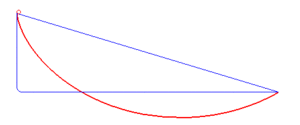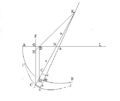Brachistochrone curve facts for kids
A Brachistochrone curve is the quickest path for a ball or object to roll between two points. Imagine you have two points, one higher than the other. If you want a ball to roll from the top point to the bottom point as fast as possible, it won't be a straight line! The Brachistochrone curve is the special shape that lets the ball get there the fastest.
This amazing curve works as the quickest route no matter how strong gravity is or how heavy the object is. However, if there is a lot of friction (like a sticky surface), it might not be the fastest path anymore. Scientists and mathematicians use advanced math to figure out the exact shape of this curve.
Contents
What is a Brachistochrone Curve?
The word "Brachistochrone" comes from Greek words meaning "shortest time." It describes a specific path that an object will follow to travel between two points in the least amount of time. Think of it like a super-fast slide!
Why is it not a straight line?
You might think a straight line is the shortest and fastest way between two points. But when gravity is involved, a straight line doesn't let the object pick up enough speed quickly. The Brachistochrone curve dips down, allowing the object to gain speed faster at the start, which helps it finish the journey in less time overall.
How does gravity affect it?
Gravity is the force that pulls things down. On a Brachistochrone curve, gravity helps the object speed up quickly as it goes down the initial steep part. Even though the path is longer than a straight line, the extra speed gained makes the total travel time shorter.
History of the Brachistochrone Problem
The challenge of finding this curve was first posed by a Swiss mathematician named Johann Bernoulli in 1696. He challenged the best mathematicians of his time to solve it.
Who solved the problem?
Many famous mathematicians, including Isaac Newton, Jacob Bernoulli (Johann's brother), Gottfried Leibniz, and Guillaume de l'Hôpital, all found the correct answer. This problem helped to develop new areas of mathematics.
Where can we see it?
While you might not see a Brachistochrone curve every day, the principles behind it are used in engineering and physics. For example, roller coasters are designed to use gravity and curves to create exciting rides, and some of their dips might be inspired by similar ideas of gaining speed efficiently.
Images for kids
See also
 In Spanish: Curva braquistócrona para niños
In Spanish: Curva braquistócrona para niños




